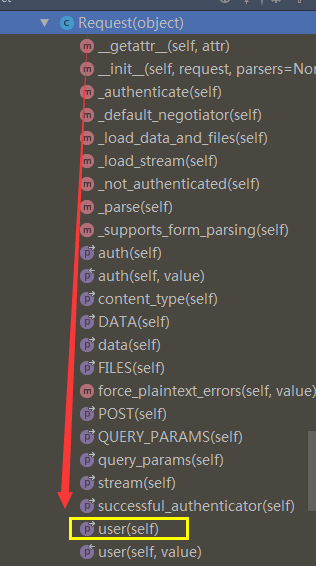259 第八篇:Django Rest Framework-RESTful规范
一 什么是RESTful
- REST与技术无关,代表的是一种软件架构风格,REST是Representational State Transfer的简称,中文翻译为“表征状态转移”
- REST从资源的角度类审视整个网络,它将分布在网络中某个节点的资源通过URL进行标识,客户端应用通过URL来获取资源的表征,获得这些表征致使这些应用转变状态
- REST与技术无关,代表的是一种软件架构风格,REST是Representational State Transfer的简称,中文翻译为“表征状态转移”
- 所有的数据,不过是通过网络获取的还是操作(增删改查)的数据,都是资源,将一切数据视为资源是REST区别与其他架构风格的最本质属性
- 对于REST这种面向资源的架构风格,有人提出一种全新的结构理念,即:面向资源架构(ROA:Resource Oriented Architecture)
二 RESTful API设计
- API与用户的通信协议,总是使用HTTPs协议。
- 域名
- https://api.example.com 尽量将API部署在专用域名(会存在跨域问题)
- https://example.org/api/ API很简单
- 版本
- URL,如:https://api.example.com/v1/
- 请求头 跨域时,引发发送多次请求
- 路径,视网络上任何东西都是资源,均使用名词表示(可复数)
- https://api.example.com/v1/zoos
- https://api.example.com/v1/animals
- https://api.example.com/v1/employees
- method
- GET :从服务器取出资源(一项或多项)
- POST :在服务器新建一个资源
- PUT :在服务器更新资源(客户端提供改变后的完整资源)
- PATCH :在服务器更新资源(客户端提供改变的属性)
- DELETE :从服务器删除资源
- 过滤,通过在url上传参的形式传递搜索条件
- https://api.example.com/v1/zoos?limit=10:指定返回记录的数量
- https://api.example.com/v1/zoos?offset=10:指定返回记录的开始位置
- https://api.example.com/v1/zoos?page=2&per_page=100:指定第几页,以及每页的记录数
- https://api.example.com/v1/zoos?sortby=name&order=asc:指定返回结果按照哪个属性排序,以及排序顺序
- https://api.example.com/v1/zoos?animal_type_id=1:指定筛选条件
- 状态码

200 OK - [GET]:服务器成功返回用户请求的数据,该操作是幂等的(Idempotent)。 201 CREATED - [POST/PUT/PATCH]:用户新建或修改数据成功。 202 Accepted - [*]:表示一个请求已经进入后台排队(异步任务) 204 NO CONTENT - [DELETE]:用户删除数据成功。 400 INVALID REQUEST - [POST/PUT/PATCH]:用户发出的请求有错误,服务器没有进行新建或修改数据的操作,该操作是幂等的。 401 Unauthorized - [*]:表示用户没有权限(令牌、用户名、密码错误)。 403 Forbidden - [*] 表示用户得到授权(与401错误相对),但是访问是被禁止的。 404 NOT FOUND - [*]:用户发出的请求针对的是不存在的记录,服务器没有进行操作,该操作是幂等的。 406 Not Acceptable - [GET]:用户请求的格式不可得(比如用户请求JSON格式,但是只有XML格式)。 410 Gone -[GET]:用户请求的资源被永久删除,且不会再得到的。 422 Unprocesable entity - [POST/PUT/PATCH] 当创建一个对象时,发生一个验证错误。 500 INTERNAL SERVER ERROR - [*]:服务器发生错误,用户将无法判断发出的请求是否成功。 更多看这里:http://www.w3.org/Protocols/rfc2616/rfc2616-sec10.html - 错误处理,应返回错误信息,error当做key。
123{error:"Invalid API key"} - 返回结果,针对不同操作,服务器向用户返回的结果应该符合以下规范。
123456GET/collection:返回资源对象的列表(数组)GET/collection/resource:返回单个资源对象POST/collection:返回新生成的资源对象PUT/collection/resource:返回完整的资源对象PATCH/collection/resource:返回完整的资源对象DELETE/collection/resource:返回一个空文档 - Hypermedia API,RESTful API最好做到Hypermedia,即返回结果中提供链接,连向其他API方法,使得用户不查文档,也知道下一步应该做什么。
123456{"link": {"rel":"collection https://www.example.com/zoos","href":"https://api.example.com/zoos","title":"List of zoos","type":"application/vnd.yourformat+json"}}
摘自:http://www.ruanyifeng.com/blog/2014/05/restful_api.html
三 基于Django实现
路由系统:
urlpatterns = [ url(r'^users/$', views.Users.as_view()), url(r'^users2/$', views.user2), ]
视图函数:
import json def user2(request): if request.method=='GET': dic = {'status':200,'name': 'lqz2', 'age': 18} return HttpResponse(json.dumps(dic)) elif request.method=='POST': dic = {'status': 200, 'msg': '修改成功'} return JsonResponse(dic) class Users(View): def get(self, request): dic = {'status':200,'name': 'lqz', 'age': 18} return HttpResponse(json.dumps(dic)) def post(self, request): dic = {'status': 200, 'msg': '修改成功'} return JsonResponse(dic)
一、请求到来之后,都要先执行dispatch方法,dispatch方法方法根据请求方式的不同触发get/post/put/delete等方法
注意,APIView中的dispatch方法有很多的功能
def dispatch(self, request, *args, **kwargs): """ `.dispatch()` is pretty much the same as Django's regular dispatch, but with extra hooks for startup, finalize, and exception handling. """ self.args = args self.kwargs = kwargs 第一步:对request进行加工(添加数据) request = self.initialize_request(request, *args, **kwargs) self.request = request self.headers = self.default_response_headers # deprecate? try: #第二步: #处理版权信息 #认证 #权限 #请求用户进行访问频率的限制 self.initial(request, *args, **kwargs) # Get the appropriate handler method if request.method.lower() in self.http_method_names: handler = getattr(self, request.method.lower(), self.http_method_not_allowed) else: handler = self.http_method_not_allowed # 第三步、执行:get/post/put/delete函数 response = handler(request, *args, **kwargs) except Exception as exc: response = self.handle_exception(exc) #第四步、 对返回结果再次进行加工 self.response = self.finalize_response(request, response, *args, **kwargs) return self.response
二、上面是大致步骤,下面我们来具体分析一下,看每个步骤中都具体干了什么事
1、对request进行加工(添加数据)
我们来看看request里面都添加了那些数据
a、首先 request = self.initialize_request(request, *args, **kwargs)点进去,会发现:在Request里面多加了四个,如下
def initialize_request(self, request, *args, **kwargs): """ Returns the initial request object. """ #吧请求弄成一个字典返回了 parser_context = self.get_parser_context(request) return Request( request, parsers=self.get_parsers(), #解析数据,默认的有三种方式,可点进去看 #self.get_authenticator优先找自己的,没有就找父类的 authenticators=self.get_authenticators(), #获取认证相关的所有类并实例化,传入request对象供Request使用 negotiator=self.get_content_negotiator(), parser_context=parser_context )
b、获取认证相关的类的具体 authenticators=self.get_authenticators(),
def get_authenticators(self): """ Instantiates and returns the list of authenticators that this view can use. """ #返回的是对象列表 return [auth() for auth in self.authentication_classes] #[SessionAuthentication,BaseAuthentication]
c、查看认证的类:self.authentication_classes
authentication_classes = api_settings.DEFAULT_AUTHENTICATION_CLASSES #默认的,如果自己有会优先执行自己的
d、接着走进api_settings
api_settings = APISettings(None, DEFAULTS, IMPORT_STRINGS) #点击继承的DEFAULTS类
DEFAULTS = { # Base API policies 'DEFAULT_AUTHENTICATION_CLASSES': ( 'rest_framework.authentication.SessionAuthentication', #这时候就找到了他默认认证的类了,可以导入看看 'rest_framework.authentication.BasicAuthentication' ),
e、导入了类看看类里面具体干了什么
from rest_framework.authentication import SessionAuthentication from rest_framework.authentication import BaseAuthentication
f、看到里面有个authenticate方法和authenticate_header方法
class BaseAuthentication(object): """ All authentication classes should extend BaseAuthentication. """ def authenticate(self, request): """ Authenticate the request and return a two-tuple of (user, token). """ raise NotImplementedError(".authenticate() must be overridden.") def authenticate_header(self, request): """ Return a string to be used as the value of the `WWW-Authenticate` header in a `401 Unauthenticated` response, or `None` if the authentication scheme should return `403 Permission Denied` responses. """ pass
具体处理认证,从headers里面能获取用户名和密码
class BasicAuthentication(BaseAuthentication): """ HTTP Basic authentication against username/password. """ www_authenticate_realm = 'api' def authenticate(self, request): """ Returns a `User` if a correct username and password have been supplied using HTTP Basic authentication. Otherwise returns `None`. """ auth = get_authorization_header(request).split() if not auth or auth[0].lower() != b'basic': return None #返回none不处理。让下一个处理 if len(auth) == 1: msg = _('Invalid basic header. No credentials provided.') raise exceptions.AuthenticationFailed(msg) elif len(auth) > 2: msg = _('Invalid basic header. Credentials string should not contain spaces.') raise exceptions.AuthenticationFailed(msg) try: auth_parts = base64.b64decode(auth[1]).decode(HTTP_HEADER_ENCODING).partition(':') #用partition切割冒号也包括 except (TypeError, UnicodeDecodeError, binascii.Error): msg = _('Invalid basic header. Credentials not correctly base64 encoded.') raise exceptions.AuthenticationFailed(msg) userid, password = auth_parts[0], auth_parts[2] # 返回用户和密码 return self.authenticate_credentials(userid, password, request) def authenticate_credentials(self, userid, password, request=None): """ Authenticate the userid and password against username and password with optional request for context. """ credentials = { get_user_model().USERNAME_FIELD: userid, 'password': password } user = authenticate(request=request, **credentials) if user is None: raise exceptions.AuthenticationFailed(_('Invalid username/password.')) if not user.is_active: raise exceptions.AuthenticationFailed(_('User inactive or deleted.')) return (user, None) def authenticate_header(self, request): return 'Basic realm="%s"' % self.www_authenticate_realm
g、当然restfulframework默认定义了两个类。我们也可以自定制类,自己有就用自己的了,自己没有就去找父类的了,但是里面必须实现authenticate方法,不然会报错。
2、进行一下操作
- 处理版权信息
- 认证
- 权限
- 请求用户进行访问频率的限制
我们主要来看一下认证流程
认证流程:
a、首先 self.initial(request, *args, **kwargs)可以看到做了以下操作
def initial(self, request, *args, **kwargs): """ Runs anything that needs to occur prior to calling the method handler. """ self.format_kwarg = self.get_format_suffix(**kwargs) # Perform content negotiation and store the accepted info on the request neg = self.perform_content_negotiation(request) request.accepted_renderer, request.accepted_media_type = neg # Determine the API version, if versioning is in use. #2.1 处理版本信息 version, scheme = self.determine_version(request, *args, **kwargs) request.version, request.versioning_scheme = version, scheme # Ensure that the incoming request is permitted #2.2 认证 self.perform_authentication(request) # 2.3 权限 self.check_permissions(request) # 2.4 请求用户进行访问频率的限制 self.check_throttles(request)
b、我们先来看认证,self.perform_authentication(request) 具体干了什么,按住ctrl点击进去
def perform_authentication(self, request): """ Perform authentication on the incoming request. Note that if you override this and simply 'pass', then authentication will instead be performed lazily, the first time either `request.user` or `request.auth` is accessed. """ request.user #执行request的user,这是的request已经是加工后的request了
c、那么我们可以从视图里面导入一下Request,找到request对象的user方法
from rest_framework.views import Request

@property def user(self): """ Returns the user associated with the current request, as authenticated by the authentication classes provided to the request. """ if not hasattr(self, '_user'): with wrap_attributeerrors(): self._authenticate() # return self._user #返回user
d、执行self._authenticate() 开始用户认证,如果验证成功后返回元组: (用户,用户Token)
def _authenticate(self): """ Attempt to authenticate the request using each authentication instance in turn. """ #循环对象列表 for authenticator in self.authenticators: try: #执行每一个对象的authenticate 方法 user_auth_tuple = authenticator.authenticate(self) except exceptions.APIException: self._not_authenticated() raise if user_auth_tuple is not None: self._authenticator = authenticator self.user, self.auth = user_auth_tuple #返回一个元组,user,和auth,赋给了self, # 只要实例化Request,就会有一个request对象,就可以request.user,request.auth了 return self._not_authenticated()
e、在user_auth_tuple = authenticator.authenticate(self) 进行验证,如果验证成功,执行类里的authenticatie方法
f、如果用户没有认证成功:self._not_authenticated()
def _not_authenticated(self): """ Set authenticator, user & authtoken representing an unauthenticated request. Defaults are None, AnonymousUser & None. """ #如果跳过了所有认证,默认用户和Token和使用配置文件进行设置 self._authenticator = None # if api_settings.UNAUTHENTICATED_USER: self.user = api_settings.UNAUTHENTICATED_USER() # 默认值为:匿名用户AnonymousUser else: self.user = None # None 表示跳过该认证 if api_settings.UNAUTHENTICATED_TOKEN: self.auth = api_settings.UNAUTHENTICATED_TOKEN() # 默认值为:None else: self.auth = None # (user, token) # 表示验证通过并设置用户名和Token; # AuthenticationFailed异常
3、执行get/post/delete等方法
4、对返回结果在进行加工


